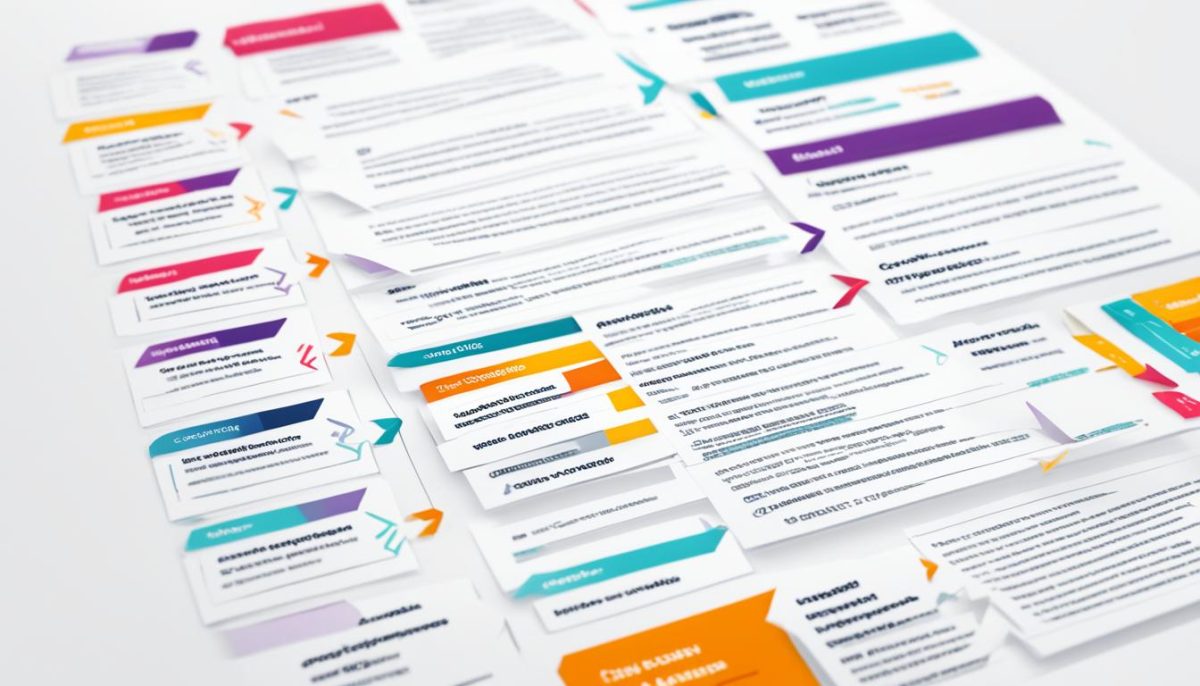SEO Tips For Boosting Your Business
Welcome to our comprehensive guide on SEO tips for boosting your business! In this article, we will share valuable insights and strategies to help you enhance your online visibility and drive more traffic to your website. Implementing these SEO techniques will give your business a competitive edge and position your brand for success in today’s digital landscape.
With the right SEO practices, you can increase your website’s ranking on search engine results pages, attract more potential customers, and ultimately grow your business. Effective SEO is crucial for businesses of all sizes, whether you’re a local retailer or a global e-commerce giant.
By optimizing your website’s structure, on-page elements, and content, you can improve your website’s visibility to search engines and potential customers. Additionally, building high-quality backlinks, leveraging the power of social media, and staying updated with the latest SEO trends and best practices are essential for long-term success.
Throughout this guide, we will explore each of these topics in detail, providing you with actionable tips and insights that you can implement right away.
No matter your industry or target audience, our SEO tips will equip you with the knowledge and strategies needed to take your business to the next level. Let’s dive in and discover how you can optimize your online presence for maximum visibility and growth!
Create an SEO-Friendly Website Structure
A well-structured website is crucial for effective SEO. By implementing a SEO-friendly website structure, you can enhance your website’s visibility and improve its search engine rankings. Here are some key strategies to create an optimized website structure:
1. Clear Navigation Menu
A clear and concise navigation menu is the foundation of a well-structured website. Use descriptive labels for each menu item, making it easy for visitors to find the content they are looking for. A logical and organized navigation menu helps search engines crawl and index your website efficiently.
2. Relevant Keywords in URL, Title Tags, and Headings
Each page on your website should have a unique URL that includes relevant keywords. This helps search engines understand the context of your page. Incorporate keywords in your title tags and headings as well, ensuring they accurately describe the content on the page. This optimization technique helps search engines determine the relevance of your website for relevant search queries.
3. Strategic Interlinking
Interlink your website’s pages strategically to create a smooth user experience and provide search engines with additional context about your content. Include relevant anchor text in your internal links to guide users to related pages within your website. This interlinking strategy helps search engines discover new pages and understand the structure of your website.
“A well-structured website enhances user experience, increases search engine visibility, & improves website rankings.” – John Mueller
4. Mobile-Friendly Design
With the increasing use of mobile devices, it’s essential to ensure your website is optimized for mobile users. Implement responsive design, which automatically adjusts your website’s layout based on the user’s device. This optimization improves user experience and contributes to better SEO performance.
5. XML Sitemap
Create an XML sitemap to help search engines crawl and index your website more efficiently. Include all relevant pages and update your sitemap regularly as you add new content. Submit your sitemap to search engines to ensure they have a comprehensive understanding of your website’s structure.
By following these SEO-friendly website structure guidelines, you can improve your website’s visibility, attract more organic traffic, and ultimately achieve your business goals.
Optimize Your Website’s On-Page Elements
When it comes to SEO, on-page optimization plays a crucial role in improving your website’s visibility and search engine rankings. By optimizing the various on-page elements, you can enhance the user experience, attract more organic traffic, and increase your chances of conversions. Here are some essential tips to optimize your website’s on-page elements:
1. Meta Title and Description
One of the key on-page elements to optimize is the meta title and description. These are the snippets that appear in search engine results, providing users with a brief overview of your page’s content. To attract search engine users, include relevant keywords in your meta title and description. Craft informative and engaging meta descriptions that entice users to click through to your website.
2. Content Optimization
Ensure your website’s content includes relevant keywords naturally and provides valuable information to readers. Avoid keyword stuffing, as it leads to poor user experience and could harm your search engine rankings. Instead, focus on creating high-quality, engaging content that resonates with your target audience. Use header tags, such as H2 and H3, to structure your content and make it easier to read and navigate.
3. Image Optimization
Optimize your images by using descriptive alt text and compressed file sizes. The alt text should accurately describe the image and include relevant keywords related to the content. This not only improves accessibility for visually impaired users but also provides search engines with valuable information about your images. Compressing image file sizes helps improve your website’s loading time, enhancing the user experience.

4. URL Structure
Ensure your URLs are concise, descriptive, and optimized with relevant keywords. A user-friendly URL structure helps search engines and users understand what your page is about. Avoid using long and complex URLs with random characters or numbers. Instead, use clear and straightforward URLs that accurately reflect the content of your pages.
5. Internal Linking
Strategically interlink your website’s pages to create a cohesive and user-friendly experience. Internal links help search engines navigate your website and understand the context of your content. When creating internal links, use descriptive anchor text that accurately describes the linked page’s content. This not only enhances your website’s overall structure but also helps improve search engine rankings.
By optimizing these on-page elements, you can improve your website’s visibility, attract more organic traffic, and provide users with an enhanced browsing experience. Remember to always focus on creating high-quality, valuable content that serves your audience’s needs.
Focus on High-Quality Content Creation
When it comes to digital marketing, high-quality content is essential for success. Creating unique and informative content that resonates with your target audience can significantly impact your online visibility and engagement. But what exactly does high-quality content mean?
High-quality content is well-researched, well-written, and provides value to the reader. It is original and stands out from the competition. To create high-quality content, start by conducting thorough keyword research to identify relevant topics that your audience is interested in. This will help you understand what questions they have and what information they are looking for.
Once you have identified your topics, weave your keywords naturally into your content. Avoid keyword stuffing, as it can negatively affect your SEO efforts. Instead, focus on providing valuable information that addresses your audience’s needs and solves their problems.
Another important aspect of high-quality content is its structure. Break up your content into sections using headings (H3), bullet points, and numbered lists to make it more scannable and visually appealing. This helps readers easily navigate and digest your content.
Additionally, incorporating images into your content can make it more engaging and visually appealing. Use relevant images that support your message and break up the text. For example, a blog post about SEO tips could include an image illustrating the importance of high-quality content creation.
Lastly, don’t forget to regularly update and refresh your content. This shows search engines that your website is active and provides fresh information to your audience. Consider repurposing your content into different formats, such as videos or infographics, to reach a wider audience and keep your content relevant.
By focusing on high-quality content creation, you can not only improve your website’s search engine rankings but also establish yourself as an authority in your industry. Remember, quality always trumps quantity when it comes to content. So take the time to create content that truly resonates with your audience and delivers value.
Build High-Quality Backlinks
Building high-quality backlinks is a crucial aspect of successful SEO. Backlinks from reputable and authoritative websites can significantly improve your website’s credibility and boost its search engine rankings. It’s not just about the number of backlinks, but also the quality and relevance of the linking sites.
One effective strategy for building high-quality backlinks is through guest blogging. Reach out to influential bloggers or industry experts and offer to write valuable content for their websites. In return, you can include a link back to your own site, creating a win-win situation for both parties.
Influencer collaborations can also be a valuable source of backlinks. By partnering with popular influencers in your niche, you can gain exposure to their followers and potentially earn backlinks from their websites or social media profiles. This can significantly boost your website’s visibility and credibility.
Another approach is to form partnerships with complementary businesses. Seek out businesses that align with your industry or target audience and explore collaborative opportunities. This could include co-creating content, hosting joint webinars or events, or simply exchanging backlinks. By leveraging each other’s networks, you can enhance your online presence and attract more high-quality backlinks.
When building backlinks, it’s crucial to prioritize quality over quantity. Ensure that the websites linking to yours are not only relevant to your industry but also have a strong online presence and positive reputation. Look for websites with high domain authority and a diverse range of backlinks themselves.
Remember, search engines value backlinks from trusted and authoritative sources. By focusing on building high-quality backlinks, you can improve your website’s credibility, increase organic traffic, and achieve better SEO results.
The Benefits of High-Quality Backlinks
Why are high-quality backlinks so important? Here are a few benefits they bring to your website:
- Improved search engine rankings: High-quality backlinks can positively impact your website’s visibility in search engine results pages (SERPs). Search engines consider backlinks as a vote of confidence, signaling that your website is valuable and trustworthy.
- Increased organic traffic: Backlinks from reputable websites can drive more organic traffic to your site. When users come across a link to your website on a reputable site, they are more likely to click on it, resulting in increased visits and potential conversions.
- Enhanced credibility and authority: Backlinks from authoritative sources can help establish your website as a credible and authoritative resource in your industry. This can lead to increased trust from both search engines and users, further boosting your website’s reputation.
- Better indexation and crawling: Backlinks play a role in determining how search engines crawl and index your website. When search engines discover multiple high-quality backlinks pointing to your site, they are more likely to crawl and index your pages, ensuring better visibility in search results.
Building high-quality backlinks may require time and effort, but the benefits they bring to your SEO efforts are worth it. By focusing on building relationships with reputable sources and providing valuable content, you can attract backlinks that have a positive impact on your website’s rankings and organic traffic.
Analyze and Monitor Your SEO Performance
Regularly analyzing and monitoring your website’s SEO performance is essential to identify areas for improvement and measure the effectiveness of your optimization efforts. By utilizing powerful tools like Google Analytics and Google Search Console, you can gain valuable insights into your website’s traffic, keyword rankings, and user behavior.
SEO performance data provides you with a comprehensive understanding of how your website is performing in search engine rankings and user engagement. With this information at hand, you can make informed decisions to optimize your website further and drive better results.
Google Analytics
Google Analytics is a robust web analytics tool that offers detailed insights into your website’s performance. By implementing tracking codes on your web pages, you can track various metrics, such as:
- Number of visitors
- Page views
- Bounce rate
- Average session duration
- Conversion rate
These metrics can help you understand how users interact with your website, which pages are performing well, and areas that need improvement. By regularly reviewing Google Analytics reports, you can identify patterns, trends, and opportunities to enhance your SEO strategies.
Google Search Console
Google Search Console is another powerful tool that allows you to monitor and optimize your website’s presence in Google search results. It provides valuable data on:
- Website indexing status
- Keyword rankings
- Click-through rates
- Website errors and warnings
- Internal and external linking
With access to this data, you can identify keywords that are driving traffic to your website and optimize your content accordingly. Additionally, Google Search Console allows you to submit sitemaps, request indexing for new or updated content, and identify crawling issues that may be affecting your website’s visibility.
Regularly analyze and monitor your website’s SEO performance to identify areas for improvement and make informed decisions to optimize your website further.
Leverage Social Media for SEO
Social media platforms are an invaluable tool for boosting your online visibility and driving traffic to your website. By creating engaging content and incorporating relevant keywords and backlinks, you can effectively optimize your social media presence for search engine optimization (SEO). Here are some strategies to leverage social media for SEO:
Create and Share Engaging Content
When using social media for SEO, it’s important to create and share content that is both valuable and captivating. Develop a content strategy that aligns with your target audience’s interests and preferences. This can include blog posts, videos, infographics, and other forms of multimedia content that are relevant to your industry or niche. Ensure that your content incorporates relevant keywords naturally to enhance its SEO relevance.
Engage with Your Audience
Responding to comments and messages promptly shows your audience that you value their engagement and interaction. By actively engaging with your followers, you can build strong relationships and foster a sense of community around your brand. This social media engagement not only strengthens your online presence but also improves your SEO performance by increasing user engagement signals.
Utilize Social Media Advertising
Social media advertising allows you to promote your content, products, or services to a wider audience. Platforms like Facebook, Instagram, and LinkedIn offer robust advertising capabilities that let you target specific demographics, interests, and behaviors. By leveraging social media advertising, you can increase brand visibility, drive traffic to your website, and ultimately improve your SEO rankings.
Collaborate with Influencers
Influencer collaborations are a powerful way to expand your reach and attract new followers. Partnering with influencers in your industry allows you to tap into their existing audience and leverage their credibility and influence. When collaborating with influencers, it’s essential to ensure that their values align with your brand’s image and that their followers are genuinely interested in your products or services.

| Social Media Platform | Benefits |
|---|---|
| Massive user base, highly targeted advertising options | |
| Visual storytelling, ideal for showcasing products and services | |
| Real-time updates, engagement with industry influencers | |
| Professional networking, B2B marketing opportunities |
By utilizing social media for SEO, you can maximize your online presence, increase website traffic, and ultimately boost your search engine rankings. Remember to consistently monitor and analyze your social media efforts to optimize your strategies and stay ahead of the competition.
Mobile Optimization for Improved SEO
With the increasing use of mobile devices, ensuring your website is mobile-friendly is crucial for SEO success. Users expect a seamless experience when accessing websites from their phones or tablets, and search engines prioritize mobile-optimized sites in their rankings. To meet these expectations and improve your SEO performance, here are some key considerations for mobile optimization:
1. Responsive Design
Implement responsive design to automatically adjust your website’s layout based on the device being used. This ensures that your content is displayed correctly and optimally on screens of all sizes. With a responsive design, users can easily navigate through your site and find the information they need, whether they are on a desktop or a mobile device. This not only improves user experience but also satisfies search engine algorithms that prioritize mobile-friendly websites.
2. Fast Loading Times
Mobile users expect websites to load quickly, and search engines take loading times into account when ranking websites. Compress images and optimize code to reduce page load times. Use caching techniques to store static files and assets, enabling faster page loading for returning visitors. By prioritizing fast loading times, you not only enhance the overall user experience but also improve your website’s SEO performance.
3. User-Friendly Navigation
Ensure that your website’s navigation is easy to use and navigate on mobile devices. Use clear, concise menus with large clickable elements that are easily tapped with a finger. Avoid complicated dropdown menus or excessive submenus that can frustrate users. A user-friendly navigation structure not only improves the user experience but also assists search engines in understanding the organization of your website.
4. Optimize Content for Mobile
When optimizing your website for mobile devices, consider the unique characteristics of mobile users. Mobile content should be concise and scannable, making it easy for users to digest information quickly. Break up large blocks of text with headings, bullet points, and images to improve readability. Use shorter paragraphs and engaging visuals to keep users engaged and encourage them to explore further.
5. Design for Touchscreens
Design your website with touchscreen interactions in mind. Ensure that buttons and links are spaced far enough apart to prevent accidental taps. Use touch-friendly elements, such as large buttons and swipeable carousels, to enhance the user experience on mobile devices. By designing for touchscreens, you create a more intuitive and enjoyable browsing experience, leading to increased engagement and improved SEO metrics.
By implementing these mobile optimization strategies, you can enhance your website’s visibility, improve user experience, and boost your SEO rankings. With the growing number of mobile users, prioritizing mobile optimization is no longer optional but a necessity for businesses that want to thrive in the online landscape.
Key Factors for Mobile Optimization
| Factors | Description |
|---|---|
| Responsive Design | Implement a responsive design that adapts to different screen sizes and devices. |
| Fast Loading Times | Optimize your website’s loading speed for improved mobile user experience. |
| User-Friendly Navigation | Create an intuitive navigation structure that is easy to use on mobile devices. |
| Optimize Content for Mobile | Format content in a mobile-friendly way, including shorter paragraphs and engaging visuals. |
| Design for Touchscreens | Create a touch-friendly design with easily tappable elements and intuitive interactions. |
Stay Updated with SEO Trends and Best Practices
The world of SEO is constantly evolving, with new trends and best practices emerging regularly. To stay ahead of the competition and maintain a competitive edge in the online landscape, it’s crucial to stay updated with the latest industry news and algorithm changes.
One way to stay informed is by following reputable SEO blogs and websites that provide expert insights and analysis. These resources offer valuable information on the latest trends, tactics, and strategies that can help you optimize your website and improve your search engine rankings.
In addition to reading blogs, attending webinars and participating in industry events can also expand your knowledge base. These platforms provide opportunities to learn from SEO experts, network with industry professionals, and gain firsthand insights into the best practices that are proven to yield results.
By implementing the latest SEO trends and best practices, you can position your website for success. However, it’s important to remember that SEO is an ongoing process, and what may work today might not be as effective tomorrow. Therefore, it’s essential to continuously adapt your strategies based on the latest industry developments to ensure long-term success in the ever-evolving world of search engine optimization.





